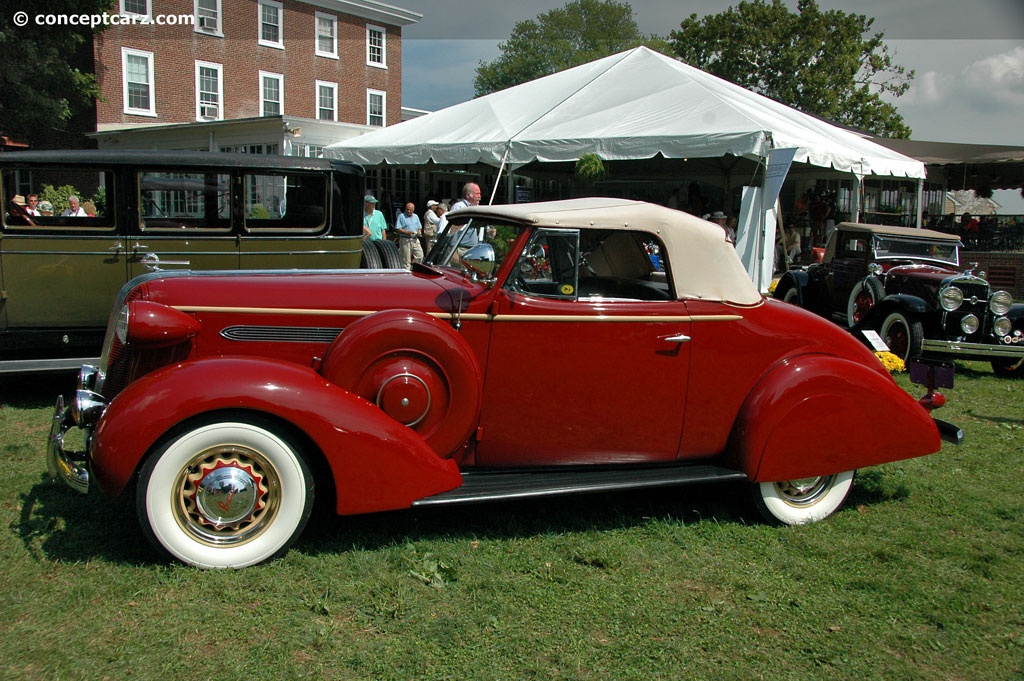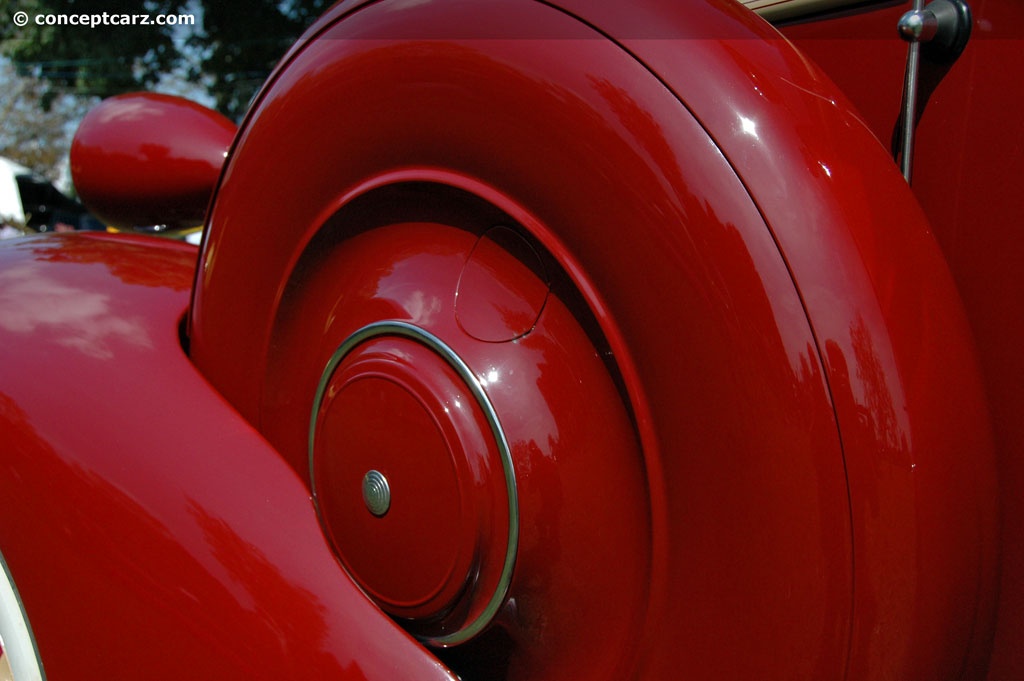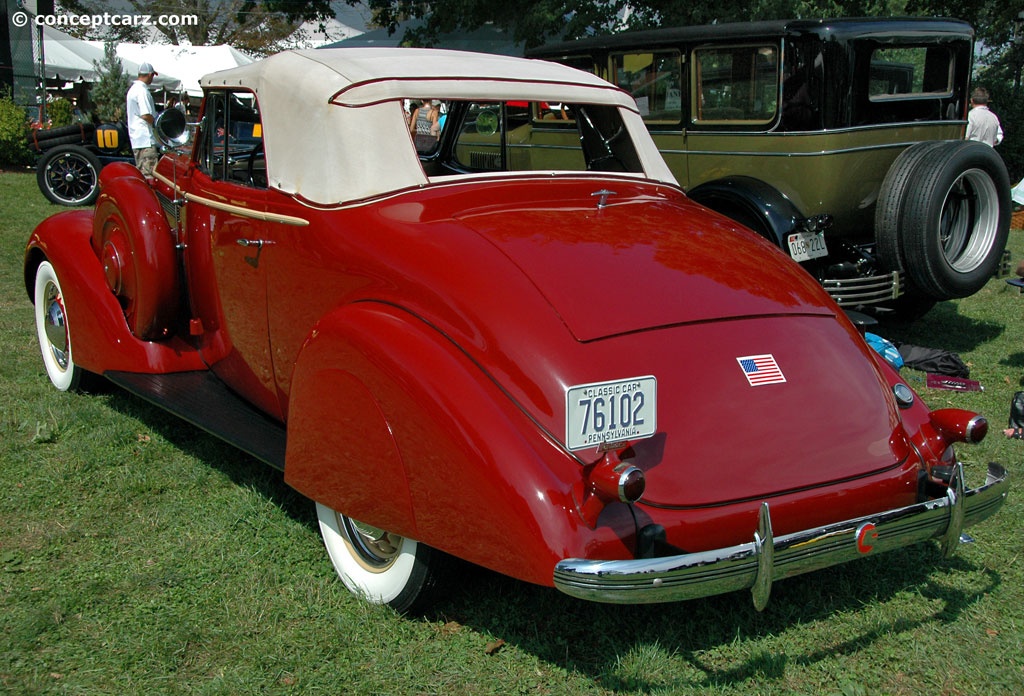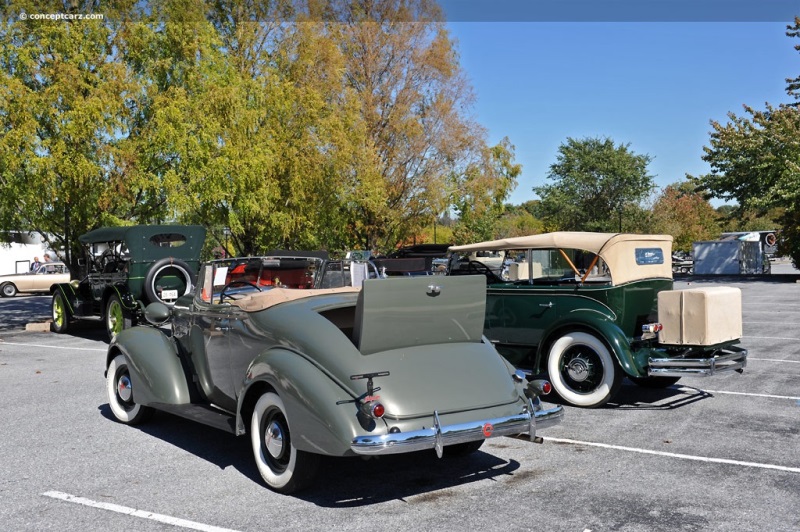The Great Depression, General Motors' hierarchy, and the youthfulness of the Pontiac brand brought about numerous changes to the Pontiac line throughout the 1930s. Pontiac was a fairly new company, having been introduced for the 1926 model year wearing bodies by Fisher and powered by a six-cylinder engine. Within GM, it was positioned above Chevrolet and below Oldsmobile, Buick, LaSalle (added in 1927), and Cadillac. 
Cabriolet
View info and historyThe Chevrolet was the 'entry-level' model and powered by six-cylinder power. Oldsmobiles from 1932 forward offered both a six- and eight-cylinder model. Buicks were powered by eight-cylinder engines of various displacement sizes and power beginning in 1931. During the early 1930s, due to the overlapping price structure and similarities between models, GM considered dropping either Oldsmobile, Buick, or Pontiac. All three survived, however, LaSalle was not as fortunate and their final year of production was 1940.Pontiac marketed a single model through 1931. In 1932, the lineup included the Pontiac Six and Pontiac Eight, with the six-cylinder unit displacing 200 cubic-inches and offering 65 horsepower while the eight had a 251 CID and 85 hp. The Six had a 114-inch wheelbase and the eight rested on a 117-inch platform. Pontiac returned to a single model for 1933, the Economy Eight powered by a new 223.4 CID straight-8 with 77 horsepower, and installed in a 115-inch wheelbase chassis. The single eight-cylinder model continued through 1934, joined in 1935 by a Standard and Deluxe Six model. Both the Standard and Deluxe Six were powered by a 208 CID inline-6, with the Standard six using non-synchromesh first gear transmissions. They also had a solid I-beam front axle and headlamp beam indicators on the instrument dial. The fenders were finished in black, they had a single taillamp, and were devoid of parking lamps o the front fenders. The Deluxe Six came with a 'Knee-Action' front suspension and all-synchromesh transmission. The front fenders carried streamlined parking lights, and the headlights used a multi-beam system. Although the single taillamps were standard, most of the cars came with dual taillamps. The 1935 Pontiac Improved Eight model rested on a longer, 116-inch wheelbase, increasing by 4-5/8-inches from the previous year. Standard equipment included dual taillights, fender safety lamps, and twin windshield wipers. 
Cabriolet
View info and historyThe 1935 Pontiac vehicles wore an all-new waterfall grille with 'Silver Streak' trim moldings along the hood. GM had embraced the modern and aerodynamic styling of the era, seen throughout the industry (albeit some manufacturers had fully embraced airplane-inspired aerodynamics, such as Chrysler with its Airflow models), with Pontiac bodies becoming more rounded, including on the grille shells and fenders. The 1936 Pontiac vehicles waterfall grilles received even more refinement with fewer 'silver streaks' and thinner shells. The headlamps became longer and slimmer and were now positioned on the sides of the hood. The 1936 Pontiac model lineup consisted of the Master Six (Series 6BB), the Deluxe Six (Series 6BB), and the Deluxe Eight (Series 8BA). All three were offered in seven different body-style options, ranging from coupes, cabriolets, to touring sedans. The base price was $615 for the two-door coupe while the top-of-the-line Touring Sedan with seating for five costs $840. The Master Six was priced from $615 to $745, the Deluxe Six listed for $665 to $810, and the top-of-the-line Deluxe Eight was $730 to $840. 
Cabriolet
View info and historyThe Master and Deluxe Six were nearly identical, except that the Deluxe Six added a 'Knee Aiction' independent front suspension, a larger fuel tank, automatic choke, and a higher capacity six-volt battery. The closed-bodied cars had taupe mohair or modified tweed pattern taupe woolen cloth upholstery. The Deluxe Eight also received the 'Knee-Action' front suspension and automatic choke, plus a pressurized cooling system. The standard sedan body style came with twin assist straps, a dash-mounted clock, oriental grain interior moldings, and armrests in the front and rear. The Master Six and Deluxe Six rested on a 112-inch wheelbase platform and had an overall length of 189.75-inches. The Deluxe Eight used a larger 116-inch platform and had an overall length of 194-inches. The additional space provided by the Deluxe Eight accommodated the larger inline-8 cylinder engine which had a 232.3 cubic-inch displacement, a Carter one-barrel carburetor, solid valve lifters, five main bearings, and offered 87 horsepower at 3,800 RPM. The six-cylinder unit had a 208 cubic-inch displacement, solid valve lifters, a Carter one-barrel carburetor, four-main bearings, and produced 81 horsepower at 3,600 RPM. Both engines were backed by a three-speed synchromesh manual transmission with a ventilated dry disc clutch and floor-mounted controls. Stopping power was by four-wheel hydraulic brakes. 1936 Pontiacs had an improved clutch, a new front suspension system with Kingpins positioned in floating bronze bearings, and an automatic choke. The eight-cylinder cars had an improved cooling system.
Cabriolet
View info and historyAlong with the larger footprint, the eight-cylinder cars had the words 'Pontiac 8' on the grille, the sixes had an oblong loop style, and the eights had a circular design. During the 1936 model year, Pontiac produced 44,040 examples of the Master Six (Series 6BB), 93,475 of the Deluxe Six (Series 6BA), and 38,755 of the Deluxe Eight (Series 8BA).
by Daniel Vaughan | Sep 2008

Cabriolet
View info and history

Cabriolet
View info and history

Cabriolet
View info and history

Cabriolet
View info and history
by Daniel Vaughan | Sep 2008
Similar Vehicles
Similarly Sized Vehicles
from 1936
Similarly Priced Vehicles
1936 Pontiac Deluxe Vehicle Profiles
Recent Vehicle Additions
Performance and Specification Comparison
Price Comparison
$620 - $760
Related Automotive News

Make Lancia Great Again: London Concours Reveals Lancia Legends Display
The London Concours has announced its Lancia Legends display – a celebration of cars from the golden era of Lancia
Line-up includes icons like Henri Toivonens Lancia 037 Rally Evo 2, a one-of-59 B24 Spider and the ultimate Flaminia a Super Sport...

RM Auctions to Present The Merrick Auto Museum Collection at 13th Annual Hershey Sale
OVER 100 BRASS ERA CARS AND SELECTION OF MEMORABILIA OFFERED ENTIRELY WITHOUT RESERVE
RM Auctions set to offer the Merrick Auto Museum Collection at Hershey auction, 10-11 October in Pennsylvania
Offered entirely without reserve, the multi...

Mercedes-Benz Classic at the 2012 Grossglockner Grand Prix
Revival of the mountain race from the 1930s
Mercedes-Benz SSK and W 125 at the start
92 bends, 14 hairpins, 15 kilometres and a 1300-metre altitude difference
The Grossglockner mountain race was one of the most prestigious motor sports event...

The Champion in Touring Car Racing : The BMW M3
In August 1985, a rumour surfaced in motor magazine Auto-Deutschland which emanated from a new sports car. An A Group Car from BMW that was a thoroughbred racing car according to the rules but was also to be produced in a version licensed to drive on...

Auctions America By RM's 2012 Auburn Spring Auction
Variety is the buzzword for this years Auctions America by RM June 1-3 Auburn Spring auction, which will offer a huge range of collector vehicles and an enormous private collection of automotive memorabilia. More than 600 American muscle cars, Classics,...





















